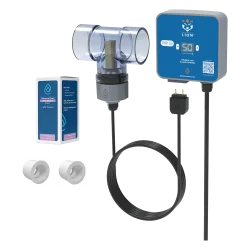If you’re considering a pool ionizer for your inground pool, have a quick read of these ideas and tips.
What are the options?
Several options are available for pool ionizers for inground pools. First, you need to decide whether you want an inline system that’s plumbed into the filtration system or a solar system that floats on top of the water.
Solar systems are inexpensive but require weekly cleaning and are always floating around. They also don’t do well with large bodies of water.
Inline systems are more heavy-duty. They have settings to adjust the output level and are plumbed with your filtration system, so they are out of the way.
Solar Ionizers
Solar ionizers are popular because they are inexpensive and easy to use—toss them in the pool. They typically release copper and may also use silver. There is much evidence to show that solar ionizers work on all types of pools, as seen in customer reviews on Amazon and other websites. However, remember that they will only work for small bodies of water, even if they get sun for part of the day. Several solar ionizer manufacturers recommend two systems for anything over 15,000 gallons.
That’s double trouble for maintenance because solar ionizers must be cleaned once a week to function. This is messy, time-consuming work that might be too much for many.
Inline Ionizers
Inline ionizers are more popular for inground pools because they are heavy-duty and professional. They require some basic plumbing and possibly electrical work to integrate them into the pool, but there are benefits aplenty.
First, inline ionizers work fine with all pool sizes and sun conditions. You can use the controls to increase or decrease the output as necessary for your specific pool.
Secondly, the electrodes used for inline ionizers are self-cleaning. This means you won’t have the weekly chore of cleaning them like you would with solar ionizers.
Inline ionizers generally have better quality, longer warranties, and better customer service than most solar ionizers.
What are the benefits?
The main benefit of pool ionizers for inground pools is using less chlorine and other chemicals to maintain clean, clear water. Without an ionizer, you rely on chlorine to take on a heavy load of algae control, oxidizing organics, and sanitizing. This means you must keep a high chlorine residual, which has many undesirable side effects.
The pool ionizer releases minerals, usually a combination of copper, zinc, and silver, that act as a natural algaecide, sanitizer, and clarifier. By using this, you can reduce the chlorine level by half, eliminate the chlorine smell, and improve the fading and drying effects of swimming.
With a pool ionizer, you will not need algaecide and will use fewer balancing chemicals. A properly ionized pool, one with a consistent residual of 0.2 – 0.4 ppm of copper, will never get algae. Since the minerals are pH neutral, whereas chlorine has a high pH, the water stays in balance longer. This saves the time and cost of adding balancing chemicals and helps the water feel softer on your skin.
Compared with other pool sanitizing devices, like UV and ozone, pool ionizers have lower costs, are easier to test, and are much better at controlling algae. Since the most significant battle you face in your backyard swimming pool is against algae, pool ionizers are much better value than these other systems.
What are the drawbacks?
The biggest drawback of pool ionizers for inground pools is that you still need to use some chlorine. They help reduce the chlorine level but do not replace it entirely.
With some pool ionizers, there is also a risk of staining. Staining happens when the copper and mineral levels go too high, and the water is out of balance. When the pH, alkalinity, and calcium that make up the Langlier Saturation Index of the water are on the high end, the water can deposit scale onto pool surfaces. When the copper level is too high, that scale will be tinted blue or turquoise. The tinted blue/turquoise scale will stain the walls, equipment, and other surfaces.
Luckily, there are carefully regulated pool ionizers for inground pools, such as the ClearBlue Mineral System. However, the pool owner always has the onus of making sure that the water chemistry is in the correct range to prevent stains.
What are the maintenance requirements?
If you buy a pool ionizer for your inground pool, your water maintenance will be reduced. However, a couple of unique things about the ionizer must be incorporated.
First, pool ionizers use copper (and sometimes zinc and silver) as a natural sanitizer. Copper is an excellent algaecide, but if the level goes too high, you could run into problems with staining surfaces, bathing suits, and blonde hair. So, you should test the copper level regularly and adjust the system’s output as required.
Secondly, pool ionizers release minerals from a mineral cell with a finite lifespan, usually around 6-12 months. So, you must replace this component once or twice a year.
Otherwise, you can maintain your water chemistry the same way you would with any pool, except you can cut the chlorine level in half.
What is the price?
A pool ionizer for inground pools costs anywhere from $400 to $1,000 and beyond. The lower-end systems do not have the same controls or minerals as the more expensive models, so you should choose based on your preferences.
For example, the Mineral Lion system has a simple controller with one function—output level—for $399.99. It uses copper and zinc in its mineral cells. The replacement cells range from $69.99 to $229.99.
The ClearBlue Mineral System, $649.99, has a more sophisticated controller with Increase and Maintain modes. This makes it easier to increase the mineral level without leaving it turned up, which can burn down the cell quicker and increase the risk of staining. It uses silver, copper, and zinc, so in addition to algae control, it is more effective at controlling bacteria and viruses. The replacement cells for the ClearBlue system range from $139.99 to $249.99.
Check out the Pool Ionizer Buyer’s Guide
Learn about Mineral Systems vs. Ozone for Pools
Learn about Ionizers vs. Saltwater Pools
-
 ClearBlue Mineral System – EPA Registered Ionizer for Hot Tubs$399.99
ClearBlue Mineral System – EPA Registered Ionizer for Hot Tubs$399.99 -
 Mineral Lion Pool Ionizer by ClearBlue IonizerPrice range: $399.99 through $599.99
Mineral Lion Pool Ionizer by ClearBlue IonizerPrice range: $399.99 through $599.99 -
 ClearBlue Mineral System – EPA Registered Ionizer for PoolsPrice range: $699.99 through $899.99
ClearBlue Mineral System – EPA Registered Ionizer for PoolsPrice range: $699.99 through $899.99




